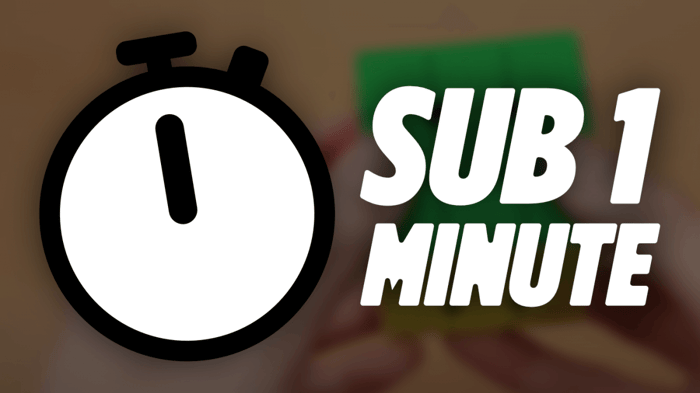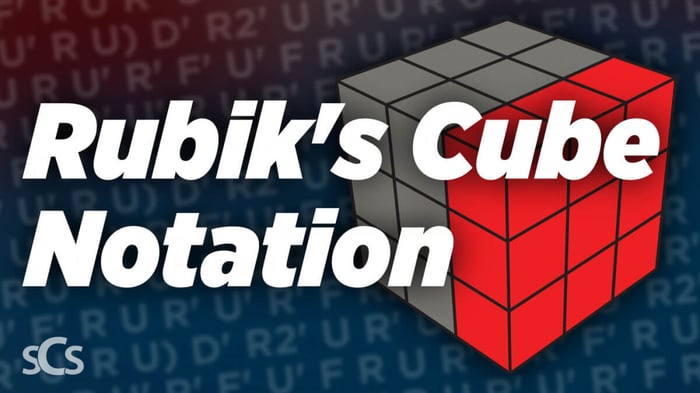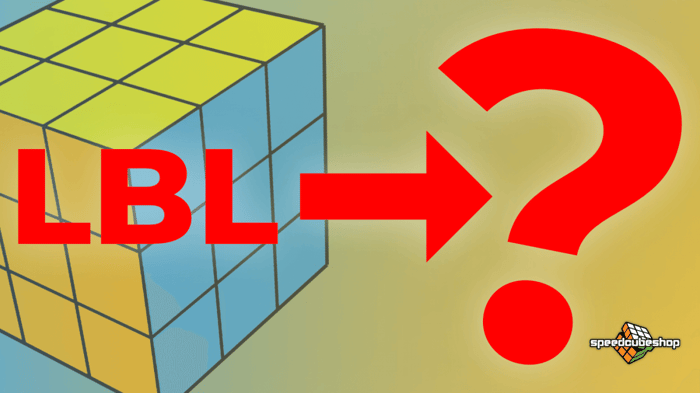Just learned how to solve the Rubik's cube with our beginner guide and looking to get faster? Here are our tips on how to become sub 1 minute on the 3x3 Rubik's cube. This guide assumes that you understand basic cubing notation and that you are able to consistently solve the 3x3 Rubik's cube with a form of beginner's method.
Haven't learned how to solve a 3x3 Rubik's Cube yet? Check out our easy solve guide here.
Hardware
Still using that dollar-store puzzle, that takes an entire wrist turn to rotate a side? Looking into newer hardware options will greatly improve both your speed and the enjoyability of your solving experience. Modern 3x3 speedcubes are extremely easy to turn, enabling you to execute "fingertricks" (more on fingertricks below), and have other quality of life improvements such as magnets to help with the aligning of layers and different stickered and stickerless finishes. Modern cubes come in all sorts of sizes, color variants, and with their own special features - so we highly advise checking out our selection on 3x3 speedcubes and reading more about finding the best speed cube to find the best fit for you.
Fingertricks
One of the biggest things to implement into your solving to break that 1 minute barrier is the use of "fingertricks". Fingertricks are what speedcubers use to turn the cube with our fingers, in an attempt to reduce unnecessary hand movements and "regripping" of the Rubik's cube. You may be used to turning the Rubik's cube with full wrist movements for each and every layer. Even with beginner's methods for solving the 3x3, your times can be improved with the use of fingertricks, with the large majority of beginners being able to break the 1 minute barrier by simply implementing more efficient ways of turning the cube.
Basic fingertricks usually start and end with the "home grip". Place your two thumbs on the front face of the cube, and your middle, index, and ring fingers on the back of the left and right layers respectively.

With this home grip, you can execute the following basic moves
| Notation | Image | Description |
| U |  |
Use your right index finger to turn the upper face |
| U' |  |
Use your left index finger to turn the upper face |
| U2 |  |
Use your index finger, followed by your middle finger to turn the upper face |
| R |  |
Rotate your right wrist 90° clockwise |
| R' |  |
Rotate your right wrist 90° anticlockwise |
| R2 |  |
Rotate your right wrist 180° clockwise/anticlockwise |
| L |  |
Rotate your left wrist 90° clockwise |
| L' |  |
Rotate your left wrist 90° anticlockwise |
| L2 |  |
Rotate your left wrist 180° clockwise/anticlockwise |
| F |  |
|
| F' |  |
|
| F2 |  |
|
| D |  |
Push D layer with left ring/pinky finger 90° clockwise |
| D' |  |
Push D layer with right ing/pinky finger 90° anticlockwise |
| D2 |  |
|
| M' |  |
|
| M2 |  |
|
Watch J Perm's full video Rubik's cube fingertricks
Optimizing and Condesncing the Beginners Method
Some simple optimizations to the 3x3 beginners method can be made to further improve your solving speed. Assuming you have learned how to solve the 3x3 from our beginners guide or something similar, a couple changes to the method can be made
Solving the cross on the bottom
In most beginners tutorials, including ours, the beginner is taught to create a "daisy" on the top, by matching up the white edges, and then rotating the four faces 180 degrees to create the cross. Faster cubers solve the cross directly onto the bottom, skipping the daisy step. This is much faster, but can be a little difficult for beginners to learn off the bat.
Start by holding the yellow center up, and the white center on the bottom. One by one, match up the edge white edge pieces to their centers as taught in the beginner tutorial, but instead of creating a daisy, solve each edge into the correct spot after aligning it with its center.
- two diagrams here
More Last Layer Algorithms
A Look into Learning an "Advanced" Method
Once you start nearing the sub 1 minute barrier, and if not lower, looking into more advanced 3x3 Rubik's cube methods will allow you to further your solve times.
CFOP
- Most similar to the beginner's method of the four most popular "advanced" methods
- Steps are
- Cross
- First Two Layers (F2L)
- Orientation of the Last Layer (OLL)
- Permutation of the Last Layer (PLL)
- A lot of resources are available since it is by far the most popular advanced speedcubing method
Roux
- Largely different from the beginner's method
- Steps are
- First Block (FB)
- Second Block (SB)
- CMLL (Corners Last Layer)
- Last Six Edges (LSE)
- Less popular than CFOP, but boasts a lower movecount (less moves required to solve the cube in comparison to CFOP)
ZZ
- Similar to CFOP
- Boasts lower movecount, and less rotations than CFOP from "orientation of edges"
- Steps
- EOLine
- ZZ F2L
- Last Layer - This can be solved in a number of ways, since the last layer edges are already oriented. Common last layer subsets include ZBLL.
Petrus
- Similar to CFOP and ZZ in last layer subsets, but similar to Roux in solving of first two layers through block building
- Steps
- Build a 2x2x2 Block
- Solve a 1x2x2 Block to create a 2x2x3
- Orient remaining edges
- Finish first two layers by completing the 2x2x3 block
- Solve last layer - similar to ZZ
Read our full article on "What Advanced 3x3 Method to Learn After Learning Beginners"
Implement Color Neutrality Early
Specifically for solvers looking to move onto the advanced solving method of CFOP as outlined above, color neutrality, the ability to solve the cross on any of the six colors, instead of just the white cross as traditionally taught in beginners tutorials.
Start by picking a different color than white, or your usual solving color, and attempt solving the cross on it. It may be a bit more difficult and may result in slower times in the short term - but color neutrality is especially worth developing whilst early in your Rubik's cube solving as it opens up more cross options in future. When solving from now on, try finding cross pieces of any color that are already solved, or close to being solved, and using that side to solve on instead of only the white side.
This is less applicable for Roux method solvers, as block building may be more difficult in comparison to cross creation in the CFOP method - although "x2y" (dual color/opposite color) neutrality is somewhat common with top level Roux method solvers.
Where to next?
Check out our article on "How to Become Sub 45 Seconds on the 3x3 Rubik's Cube"
For a new challenge, check out our article on deciding your next twisty puzzle to learn.





























